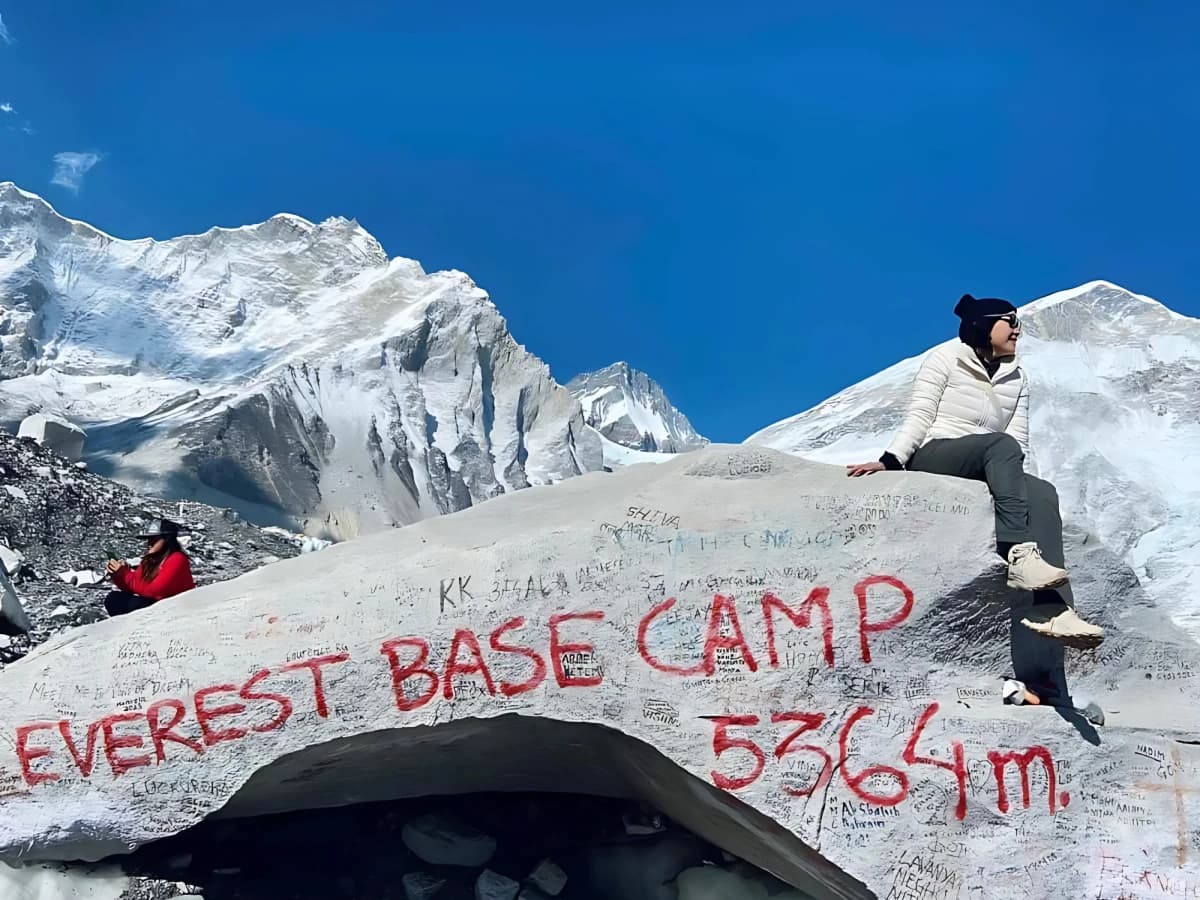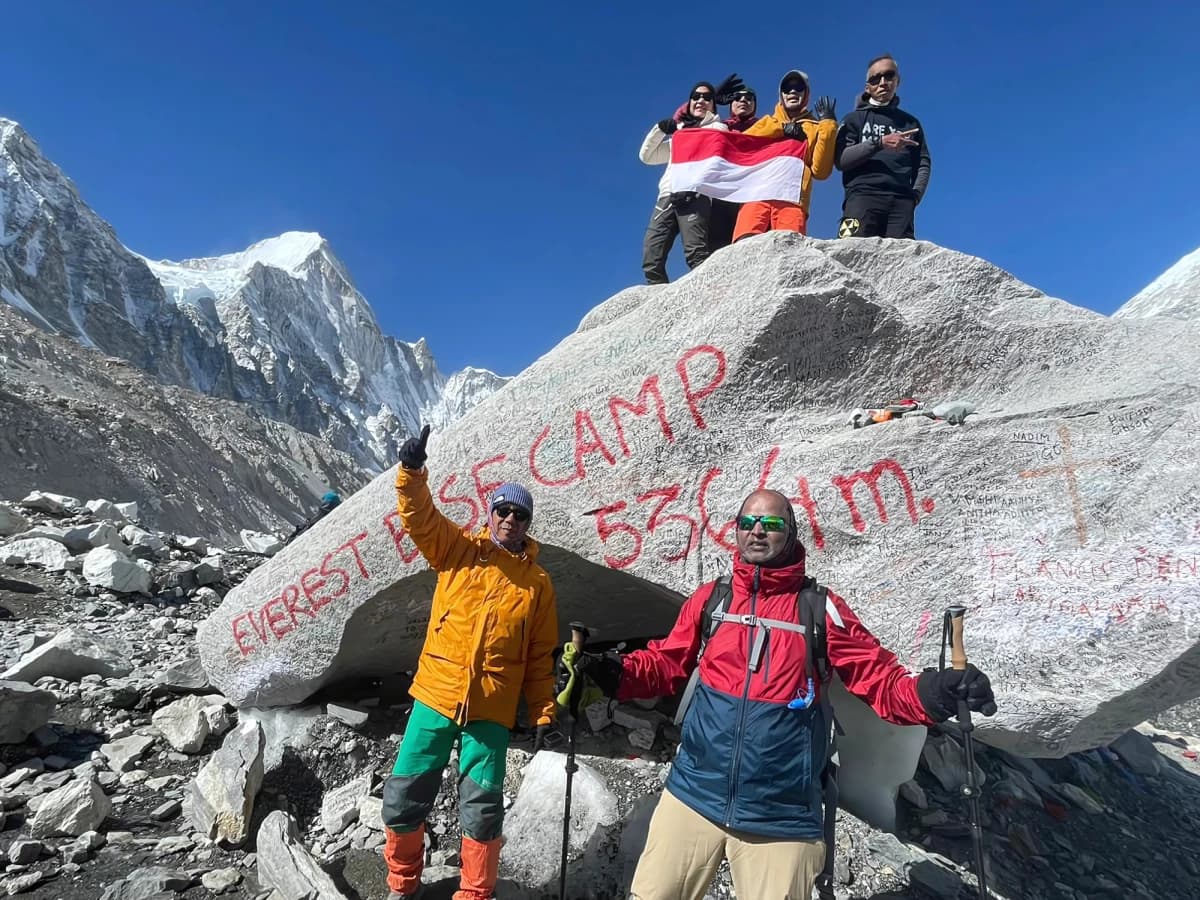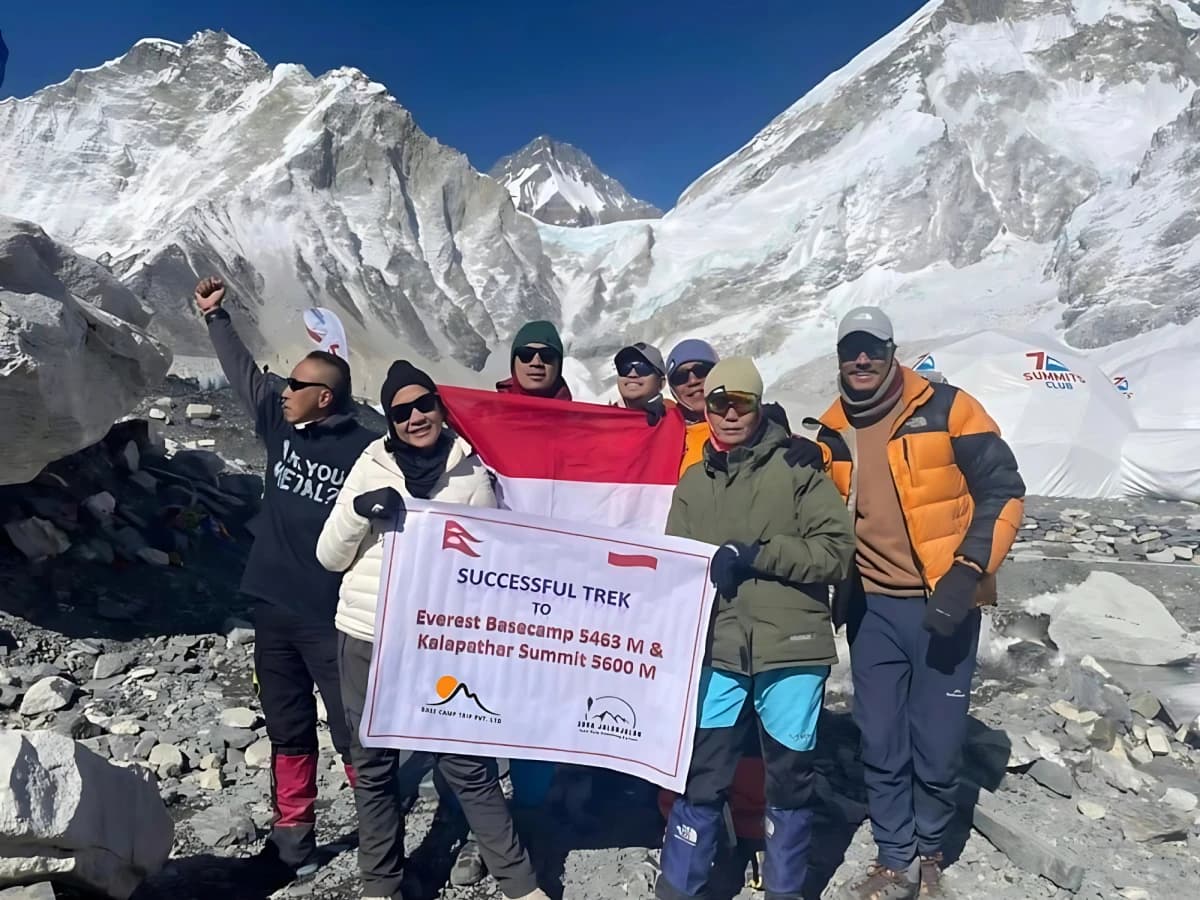The Everest Base Camp trek with Gokyo Lakes & Cho La Pass is an adventurous long trek in the Everest region that doesn't follow the classic EBC itinerary and takes you to untouched parts of the region. It is a demanding trek that explores glacier moraines and beautiful Gokyo Valley and crosses Cho La Pass.
If you are looking for a unique Everest Base Camp itinerary and want to explore untouched parts of the Everest region, the Everest Base Camp trek with Gokyo Lakes & Cho La Pass is a great option. Because this trek crosses a high altitude pass, previous trekking experience and strong fitness are required.
The trek starts with the Lukla flight and hikes to Namche Bazaar, following the Dudh Koshi River. On the way, you will spend a night in Phakding village and cross the iconic Tenzing Hillary Suspension Bridge. It is the longest suspension bridge you will come across on this trek.
Namche Bazaar is the biggest Sherpa settlement and a tourist hub. Here, you will spend an acclimatization day as well, which involves hiking to the Hotel Everest View. The trail then continues to Tengboche Monastery and descends to the Imja Khola Valley Floor.
Trekking through the Pangboche village, you will hike via terraced fields to Dingboche village. From here, hike to Nangkartshang Peak or Chhukung Valley to acclimatize. The next day, you will walk above the tree line and follow the Khumbu Glacier moraine to Lobuche village.
After Lobuche, Gorak Shep is the last settlement before Everest Base Camp. The trail is steep and rocky, and the high altitude makes walking quite challenging. At EBC, you will enjoy a close view of the Khumbu Glacier and Khumbu Icefall.
To see a closer view of Mount Everest, you will hike to Kala Patthar. The trail then retraces the route back to Lobuche village and follows a different way to Dzongla. You will see Chola Tsho Lake and stunning mountain vistas on the way.
From Dzongla, the trail gradually ascends over rocks and mountain ridges and joins icy trails to Cho La Pass (5,420 m/17,782 ft). Crossing Cho La Pass will be one of the longest days on this trek. The top of the pass will reward us with spectacular mountain scenery.
Spending a night at Thangnak, you will hike to Gokyo village, traversing the Ngozumpa Glacier moraine. The Gokyo village is situated near the third Gokyo Lake. You will pass by the first and second Gokyo Lakes while hiking.
You will go on a side hike to Gokyo Ri and the fourth and fifth Gokyo Lakes later in the day. The following day, you will descend to Dole via Machhermo village. From here, you will trek back to Namche Bazaar and retrace the route to Lukla.
Highlights
- Experience the famous Lukla flights and stunning aerial views of the Himalayas during the flight
- Trek through lush rhododendron forests, cross alpine terraces, walk on steep, rocky tracks, and traverse Glacier Moraine
- Crossing many suspension bridges over the Dudh Koshi River, including the long Tenzing Hillary Suspension Bridge
- Explore the iconic Namche Bazaar and spend an acclimatization day here
- Witness diverse landscapes as the climate, vegetation, and environment change while ascending and descending
- Explore ancient monasteries like Tenboche and Pangboche on the way
- Get to see the daily lives of the Sherpas and other mountain communities
- Meet with many like-minded trekkers and make lifelong memories
- Witness stunning mountain views throughout the journey
- Reach Everest Base Camp and Kala Patthar
- Traverse the Ngozumpa Glacier moraine and hike to Gokyo Valley
- Explore beautiful Gokyo Lakes and witness a jaw-dropping mountain view from Gokyo Ri
Why should you do the Gokyo Cho La Pass trek?
- Thrilling Lukla flight: The Lukla flights are one of the major highlights of trekking in the Everest region. This flight is famous because of its small airport and a very high altitude of 2,846 m/9,337 ft. Flying in and out of Lukla will also present outstanding aerial views of the Himalayas.
- Adventure trekking: While trekking to EBC and Gokyo Lakes, you will trek through lush rhododendron forests, cross alpine terraces, walk on steep, rocky tracks, and traverse Glacier Moraine. The trail is very adventurous and also includes hanging bridges and crossings.
- Namche Bazaar: Namche Bazaar (3,440 m/11,290 ft) is the biggest Sherpa village in the Everest region. It is also a tourist hub and has many cafes, restaurants, shops, and museums. You will have access to many modern conveniences here before hiking further into remote corners of the Everest region.
- Diverse landscapes: The climate drastically changes from Lukla to Everest Base Camp to Cho La Pass. You will traverse from lush hills to alpine meadows to the glacial zone. The change in climate, vegetation, and environment brings change in landscapes.
- Ancient monasteries: Everest region houses deep cultural heritage and beliefs of the locals. The Everest Base Camp trek with Gokyo Lakes & Cho La Pass is not only adventurous but also culturally enriching. You will visit ancient monasteries like Tengboche and Pangboche on the way. Likewise, you will also have many chances to talk to locals about their faiths and traditions.
- Sherpa community: Sherpas are the natives of the Everest region. They are famous around the world for their strength and resilience. If you have ever wondered how their lifestyle and practices are, this trek will give you a close glimpse.
- Stunning mountain vistas: The best thing about high-altitude treks are the outstanding mountain vistas, and the EBC Gokyo Cho La Pass trek will not let you down. You will see many incredible mountains on this trek, such as Thamserku, Ama Dablam, Everest, Lhotse, Nuptse, Makalu, Cho Oyu, Island Peak, Cholatse, Pumori, Kanchenjunga, etc.
- Everest Base Camp and Kala Patthar: Everest Base Camp is the lap of the tallest mountain in the world. Trekking here is a huge achievement. Located 5,364 meters (17,598 ft) above sea level, EBC is the closest you can get to Mount Everest without a climbing permit. Likewise, Kala Patthar (5,545 m/18,192 ft) is a viewpoint from which you can see Mount Everest's closest view.
- Cross Cho La Pass: Cho La Pass (5,420 m/17,782 ft) is one of the three high passes in the Everest region. Crossing it is very challenging and requires 9 to 10 hours of walking. You need an expert mountain guide who knows the route to safely cross the Cho La Pass. Even though climbing Cho La is demanding, the top of the pass will reward us with jaw-dropping scenery.
- Travers Ngozumpa Glacier: You will cross Ngozumpa Glacier moraine on the way from Thangnak to Gokyo village. It is the biggest glacier in Nepal. Crossing this glacier is quite iconic and makes your journey even more special.
- Explore Gokyo Lakes and Gokyo Ri: There are six main Gokyo Lakes. They range from 4,500 meters to 5,000 meters. These lakes are freshwater lakes. The beauty and isolated locations of the lakes attract many trekkers. Likewise, Gokyo Ri (5,357 m/17,575 ft) is a viewpoint near Gokyo village from where you will see a marvelous sunrise and breathtaking mountain panorama.
Everest Base Camp trek with Gokyo Lakes & Cho La Pass difficulty
- Challenging difficulty (Tougher than the standard Everest Base Camp trek)
- Daily walking hours: 6 hours
- Suitable for beginners? No
The Everest Base Camp with Gokyo Lakes & Cho La Pass is one of the most challenging itineraries in the Everest region. This trek is for experienced trekkers with good fitness and previous high-altitude exposure.
There are many factors that make the Everest Base Camp trek with Gokyo Lakes & Cho La Pass demanding, but with the right team, completing it is not impossible. Please read below for more information on the difficulties and resolutions for this amazing trek:
- The never-ending uphill and downhill walking: Many trekkers do not realize how challenging it can be to traverse Himalayan terrain. Imagine walking uphill and downhill constantly. Your knees, back, and core muscles will always be on fire. However, there is a trick to conquer those long ascents and descents. First, you need good stamina and strength. Second, walk slowly and maintain a pace. You do not want to tire yourself in the first 3-4 hours of walking and literally drag yourself in the last few hours.
- High altitude: High altitude and its effects are no joke. The high altitude begins to kick in once you go above 3,000 meters to 3,500 meters. Every step will become tough, and you will suffer not only physically but also mentally. How do you handle high altitudes? Acclimatization and preserving your energy.
- Weather risks: You might wonder how weather can make trekking difficult. Unfavorable weather can lead to unclear views, cold/hot climates, and snowfall/rainfall. It can also affect mountain views, Lukla flights, and how you feel, making the trail even more challenging. Spring and autumn seasons have the least weather risks.
- Long trekking hours: Every day, you will walk at least 6 hours during the Everest Base Camp with Gokyo Lakes & Cho La Pass. It is not easy, especially when you go above the treeline. You must have strong willpower and determination to push yourself to complete the trek.
- Wilderness and limited services: Please note that trekking in the Himalayas means traveling in remote areas, and remote areas do not have modern conveniences. You will experience a basic mountain lifestyle, stay unconnected to the rest of the world for the majority of the trip, and have simple but quite good food. The services will be limited and costly, but they will allow you to embrace nature.
- Physical inconveniences: Based on the above information, there are physical and even mental inconveniences during Everest Gokyo Cho La Pass trekking, and conquering them makes this trek unforgettable. You will deal with low oxygen levels, rugged terrain, a very cold climate, potential risk of frostbite, altitude sickness, backache, headache, etc. But do these nuisances keep adventurers away from doing this trek? No. There is no trip in the world without a drawback. You just have to figure out a way to work around it, and we will help you with that.
Preparation for Everest Base Camp Cho La Pass Gokyo trek
The Everest Base Camp trek with Gokyo Lakes & Cho La Pass is more challenging than the general EBC trek, so the physical requirements are higher. Crossing the Cho La Pass is the most difficult part of this trek, and trekkers have to be physically and mentally able to push themselves.
If you think you lack physical and mental fitness for the EBC Gokyo Cho La trek, please follow the below tips:
- Physical preparation: To gear yourself physically for this trek, you have to exercise to improve your fitness, strength, and endurance. Work out 4 to 5 times a week at least, and make sure to include cardio in your routine. If there are hiking routes near you, consider doing at least 2 to 3 hikes in a month.
- Long walks: The basic requirement for trekking in the Himalayas is 6 to 7 hours of walking each day. Without a walking habit, it is tough to pull off. So, we highly recommend going on long walks, preferably with a backpack weighing 5 kg.
- Mental preparation: While you train your body, you will also become mentally strong. In addition to that, trekkers should learn about the EBC and Gokyo Lakes trek routes. Likewise, watch videos of Cho La Pass crossing on YouTube. This will make you aware of what to expect during the trek, and there will be fewer unwanted surprises.
Why should you do the Everest Base Camp trek with Gokyo Lakes & Cho La Pass with us?
You need a reliable local team to pull off the Everest Base Camp trek with Gokyo Lakes & Cho La Pass. We, Base Camp Trip, specialize in organizing treks in Everest. We will take care of logistics and permits and also provide you with a local guide for the journey.
We will make all the bookings and reservations, which makes the trek hassle-free for you. Likewise, we have the Everest Base Camp Trek with Gokyo Lakes & Cho La Pass cost. You will get value for your money and time.
Book your seat now and enjoy the best price and service. If you have any questions, feel free to contact us.




